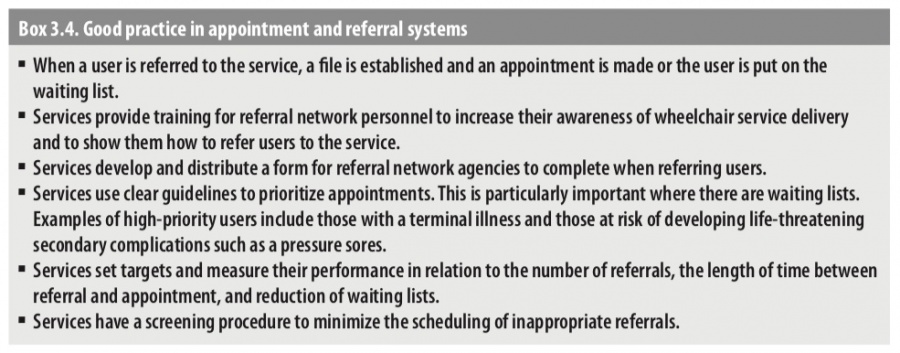Wheelchair Referral and Appointments: Difference between revisions
No edit summary |
No edit summary |
||
| Line 26: | Line 26: | ||
== Good Practice == | == Good Practice == | ||
[[File:Good Practice - Appointments & Referrals.jpeg|none|thumb|900x900px|<ref>William Armstrong, Johan Borg, Marc Krizack, Alida Lindsley, Kylie Mines, Jon Pearlman, Kim Reisinger, Sarah Sheldon. Guidelines on the Provision of Manual Wheelchairs in Less Resourced Settings. World Health Organization; Geneva: 2008. </ref>]] | |||
== Resources == | == Resources == | ||
Revision as of 22:03, 4 July 2018
Original Editor - Your name will be added here if you created the original content for this page.
Top Contributors - Naomi O'Reilly, Kim Jackson, Uchechukwu Chukwuemeka and Amrita Patro
Introduction[edit | edit source]
Referral[edit | edit source]
Referral means: sending or directing a person to the right place for care or assistance.
There are different ways in which wheelchair users may be referred to a wheelchair service. For example, wheelchair users may:
- Hear about the service and come themselves;
- Be directed to the service by the local hospital, community health centre,community-based rehabilitation service, village/council/church leaders, disabled people’s organizations, other wheelchair users.
Wheelchair services can help to increase the number of wheelchair users who are referred to the service by making sure that all possible referral sources know about the service.
Providing referral sources with a referral form can help to give the wheelchair service some simple initial information about the wheelchair user. each wheelchair service needs to decide whether it will find a referral form useful, what information to include and how the form will be used (for example posted to the service, or handed to the wheelchair user to bring along).
Appointment[edit | edit source]
When a wheelchair user is referred to a wheelchair service, they should be given an appointment for an assessment, if they cannot be attended to on the same day. The appointment may be for the user to visit the service/centre, or for wheelchair service personnel to visit the user.
An appointment system helps wheelchair service personnel organize their time efficiently, it also means that wheelchair users do not have to wait around to see the service personnel.
The way an appointment is made depends on how easy it is to get a message to the wheelchair user. For example, messages may be sent by post, by phone or through the original referral source.
Sometimes, wheelchair users will arrive without an appointment. if possible, see them on the same day, especially if they have travelled a long way.
Good Practice[edit | edit source]
Resources[edit | edit source]
References[edit | edit source]
- ↑ William Armstrong, Johan Borg, Marc Krizack, Alida Lindsley, Kylie Mines, Jon Pearlman, Kim Reisinger, Sarah Sheldon. Guidelines on the Provision of Manual Wheelchairs in Less Resourced Settings. World Health Organization; Geneva: 2008.







